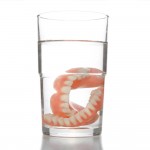
Despite improvements in oral health a significant proportion of the population suffer from partial of complete tooth loss. While the use of dental implants for the replacement of missing teeth has grown substantially in recent decades the use of removable prostheses remains common. Good prosthesis hygiene is necessary to bacterial and fungal colonisation and prevent stomatitis.
The aim of this review was to assess the evidence about the hygiene practices of removable prostheses relative to the effectiveness, colour and dimensional stability. It also aimed to identify patients’ attitudes and habits towards denture hygiene.
Methods
Searches were conducted in the Cochrane Library, Medline and SCOPUS databases and reference lists of identified papers. Only English language controlled clinical trials (CCTs) involving at least 10 patients with no clinical signs of denture stomatitis were considered.
Two reviewers independently selected studies and abstracted data. Risk of bias was assessed using the Cochrane tool for randomised controlled trials (RCTs) and the MINORS Index for non-randomised controlled trials (N-RCTs). Overall quality was assessed using the GRADE approach. A narrative summary of the findings was presented.
Results
- 25 studies were included: 21 studies (17 RCTS, 4 N-RCTs) examined the effectiveness of the hygiene approaches; 3 studies examined colour stability; 2 studies considered microwave disinfection and dimensional stability. Of the 21 studies 16 were considered to be at high risk of bias, 2 at moderate risk and 3 at low risk.
- 30 articles investigated the attitudes and habits of removable denture wearers towards the hygiene of their prostheses (frequency, type of hygiene, nocturnal wearing).
- Of the 21 studies 4 investigated chemical agents including effervescent tablets and/or solutions1 (alkaline peroxide, sodium perborate, potassium peroxymonosulphate, sodium bicarbonate and potassium monosulphate glutaraldehyde, sodium hypochlorite, chlorhexidine digluconate; 3 toothbrusing ; 2 irradiation (photodynamic, microware) ; 12 mechanical, chemical and combinations.
Conclusions
The authors concluded: –
the current study demonstrated that the combined application of different types of hygiene practices in removable prostheses, namely mechanical interventions in conjunction with chemical agents, achieves optimal outcomes in terms of hygiene effectiveness. Despite the limited number of existing clinical trials investigating the effect of hygiene practices on colour and dimensional stability of removable dentures, it seems that microwave disinfection leads to insignificant alterations in dimensional stability of prostheses. Colour instability of dentures subjected to hygiene interventions is dependent on the critical concentration of chemical solutions as well as the duration of the chemical agent application. Denture brushing is the most commonly applied hygiene practice among denture wearers worldwide. The registered denture wearers’ habits and attitudes towards the hygiene of their removable prostheses indicate that evidence-based removable prostheses hygiene guidelines should be communicated to patients.
Comments
This review aimed to address 4 questions for patients wearing removable dentures,
What is the effect of difference hygiene practices on
- denture biofilm and microorganisms,
- denture sanitation
- prosthesis colour stability
- prosthesis dimensional stability
Three major databases were searched for relevant papers although restricting inclusions to the English language may have excluded some papers as noted by the authors. While a good number of studies could be included that a relatively small in size with the number of participants ranging from 15-80 patients. Only 3 of the trials were considered to be at low risk of bias. The authors suggest that his review supports the current guidelines of American College of Prosthodontists, suggesting that removable dentures be cleaned daily by soaking and brushing with an effective and non-abrasive denture cleanser (Dental Elf – 21st Jul 2011). The evidence also found that brushing of the removable dentures represents the most commonly applied cleansing method of removable denture wearers.
Links
Primary paper
Papadiochou S, Polyzois G. Hygiene practices in removable prosthodontics: A systematic review. Int J Dent Hyg. 2017 Nov 9. doi: 10.1111/idh.12323. [Epub ahead of print] Review. PubMed PMID: 29120113.
Other references
Dental Elf – 21st Jul 2011
